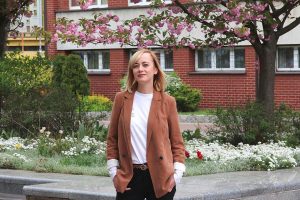Aleksandra Jabłońska-Błokowska, a graduate of the Faculty of Arts in Cieszyn, cooperates with both young and older people, sharing her love for music.
A music band is not only a group of people performing together on stage. These are people who share vivid relationships, who regularly meet to talk and achieve their goals together. And it does not matter who makes the band. Preschoolers cooperate with high school students and older people. Everyone brings some good. This is the vision of cooperation of Aleksandra Jabłońska-Błokowska, who, by implementing various musical projects, shares her passion for music with others.

I was particularly impressed by the way the „Harmonia” Choir of the University of Silesia in Cieszyn was conducted by Professor Izabella Zielecka-Panek. I was associated with the choir throughout my entire studies. It was a wonderful experience! I think that it is the Professor who is responsible for how I run various music bands today. It was under her supervision that I learned the art of conducting; I also watched her while she was working with the Cieszyn choir. Certainly, it is extremely important to build emotional ties with your protégés ‒ it is not only a group of people performing together on stage, but above all people who share various relationships. Today these relationships are particularly important. I teach children and young people that it is really great to meet outside of virtual reality, do something together, and then enjoy the wonderful effects of cooperation.
Most of my pupils will not connect their lives with music. Being members of the band, they learn not so much to sing, but above all to be with each other. And that means being able to cooperate both in music and in life. Each of them learns to cooperate and be responsible for the tasks delegated to him or her; they learn to be responsible not just for oneself but also for a friend standing next to them. And I, by conducting, unite the group and teach harmony in action.
So six-year-old kids and nineteen-year-olds work together – that is phenomenal and looks great in, for example, the music videos we have made. Younger children infect everyone with energy and courage. They do not know what stage fright is. The older, in turn, take on the role of carers. And the older people? They share knowledge and calmness in approaching the implementation of various tasks. What is more, this type of intergenerational cooperation means that the topics discussed are not restricted to the area of music, but they quickly enter into the depth of life experiences. This was especially noticeable during the implementation of the project ‘Musicians on the trail of Jan Kiepura’, in which both older and young people from Sosnowiec took part, creating a unique intergenerational choir.
A great advantage of such cooperation is getting to know oneself and the needs of people belonging to different age and often also social groups. The spontaneity of young people and the accuracy of older people combine in a common experience of dancing and singing.
I also get a lot from such cooperation: I learn the sensitivity of other people, I look at the people I work with, I adapt the language, the form of communication, I help find the right means of expression, I look for what connects us to further deepen the relationship, which, in the end, does not turn out to be so difficult, because I use a great tool, which is music. And what if somebody cannot sing? Well, it does not matter. Music can be created in many different ways.
Photography: Małgorzata Kłoskowicz





